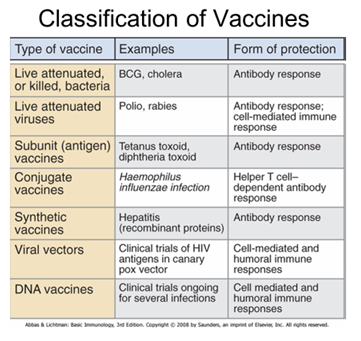FA16 Immunization Module’s Updates
Relative Safety of Vaccines and Public Fear
The creation of the vaccine has protected many lives. However, in today’s society, the fear of vaccine use is an issue. A high topic of interest that came out in the 1990’s was the fear of vaccines causing autism. Andrew Wakefield, the author of a paper claiming a connection between the measles, mumps, and rubella (MMR) vaccine and autism. This was later disproven as it had falsified information and the author had financial conflicts involved [1]. Fears such as this still remain to this day, however. It is for this reason the safety of vaccine use needs to be publicized and easily understandable to the public.
The basic function of a vaccine is to essential teach and prepare the human body to fight off a specific foreign substance, or in other words, an antigen. There are several types of vaccines as shown in the table below from “Immunization” PowerPoint presentation [2].
Rather than focus on how each of these vaccines work, notice the forms of protection that each provide. The protection is what the body naturally produces in response to antigen termed “active immunity”. After a person survives an infection “with the disease-causing form of the organism,” that person’s body will have created ways to fight off that same disease in the future. A vaccine, however, will produce a similar response but without the fear of fighting off a life threatening illness [3].
In order for a vaccine to provide this protection, there are two basic types, live attenuated and inactive. Live attenuated is a modified form of the disease-causing agent which is unable to cause the disease but is still able replicate. The inactive vaccines essential have either the whole virus or bacteria that area dead or are portions of the organism that would cause an immune response [3].
[page 3]
Either way, after administration of either of these to the human body, the body will react creating an immunity to the live, life-threatening bacteria or virus that may enter the body’s system later.
The main adverse reaction to administration of a vaccine is usually only a milder form of the disease it is attempting to prevent. This is due to the live attenuated vaccine. The inactive vaccines usually only cause a small local problem where it was administered and may or may not have a fever associated. There are three contraindications to vaccination, though, which have to do with whether a person had a severe allergic reaction “to a vaccine component,” “Enchephalopathy without a known cause occurring within 7 days of a dose of pertussis-containing vaccine,” and infants with SCID are not to be given the rotavirus vaccine [4].
In summation, a vaccine works by preparing the body to fight of potentially hazardous antigens later on. It does this by activating natural body defenses by introducing mild forms of the bacteria or virus or a dead form. In the end, it is a safer means of protection as nothing truly harmful is being inserted into the body. By the sharing of this basic understanding on how vaccines works, it may be helpful to diminish some fears of the public.
Of course, continuing researcher on vaccine safety is goal of the CDC through the Immunization Safety Office (ISO). More information on this program can be found at www.cdc.gov [5].
Resources:
(1) http://www.poison.org/articles/2010-oct/vaccines-do-not-cause-autism
(2) Immunization Basic Powerpoint. Slide #12
(3) Principles of Vaccination, page 1, 3-4
(4) http://www2a.cdc.gov/nip/isd/ycts/mod1/courses/genrec/10365.asp?seg=A
(5) http://www.cdc.gov/vaccinesafety/ensuringsafety/history/index.html




I find it interesting that you brought up the vaccines cause autism epidemic as it is one that I would have been interested to experience had I been alive at that time. I recently remember talking to my family about this epidemic and how they felt about it, and I found that some of my family still harbored concern that the vaccine in fact did cause autism even though we know this to be false. I don't know if this is a problem in our country with trusting science or healthcare professionals in general, but in the future will all our leaps in tech and medicine, I wonder if we will have a harder time convincing our patients of certain medical facts, procedures, medicines, vaccines, etc. that may seem too futuristic for certain segments of the population.